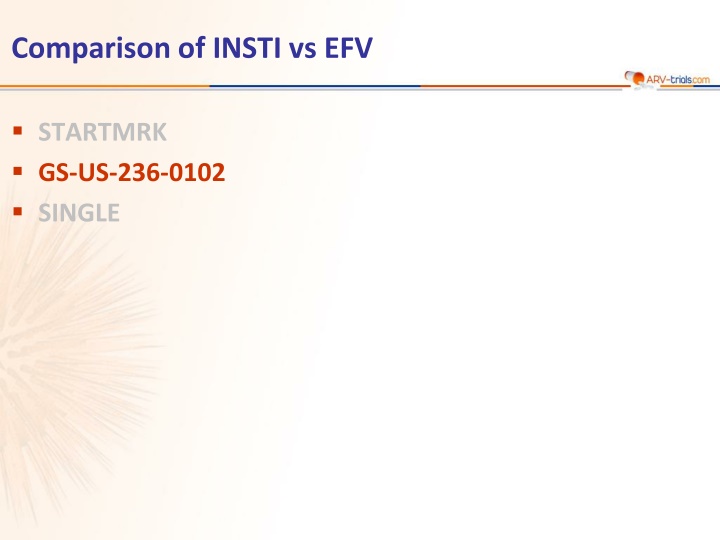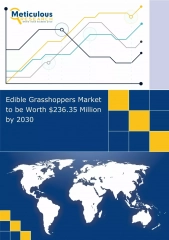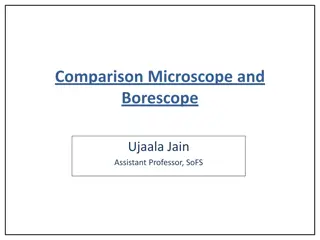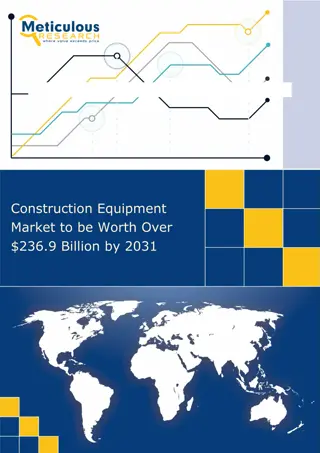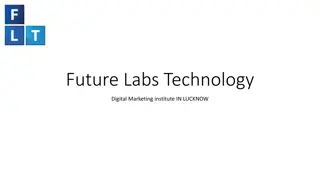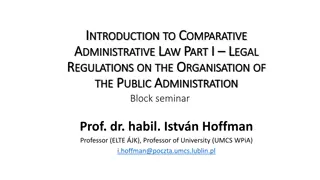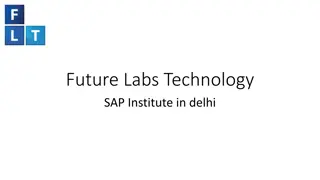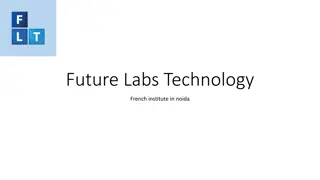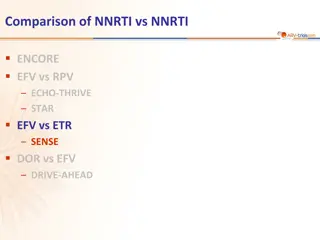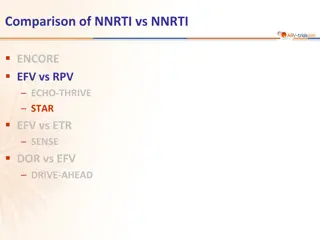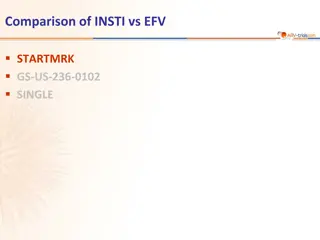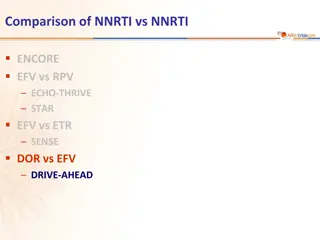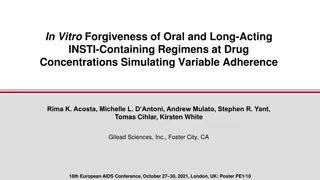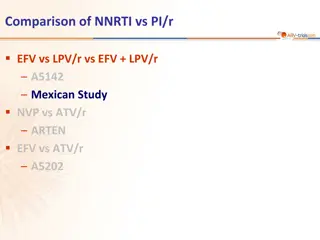Comparison of INSTI vs. EFV in Study GS-US-236-0102
Study GS-US-236-0102 compared EVG/c/FTC/TDF vs. EFV/FTC/TDF in treatment-naive HIV patients. Objective was non-inferiority of EVG/c/FTC/TDF at week 48 with HIV RNA
Download Presentation

Please find below an Image/Link to download the presentation.
The content on the website is provided AS IS for your information and personal use only. It may not be sold, licensed, or shared on other websites without obtaining consent from the author.If you encounter any issues during the download, it is possible that the publisher has removed the file from their server.
You are allowed to download the files provided on this website for personal or commercial use, subject to the condition that they are used lawfully. All files are the property of their respective owners.
The content on the website is provided AS IS for your information and personal use only. It may not be sold, licensed, or shared on other websites without obtaining consent from the author.
E N D
Presentation Transcript
Comparison of INSTI vs EFV STARTMRK GS-US-236-0102 SINGLE
Study GS-US-236-0102: EVG/c/FTC/TDF QD vs EFV/FTC/TDF QD Design Randomisation* 1 : 1 Double-blind W48 W192 EVG/c/FTC/TDF 150/150/200/300 mg QD N = 348 > 18 years ARV-na ve EFV/FTC/TDF placebo HIV RNA > 5,000 c/mL Any CD4 cell count eGFR> 70 mL/min EFV/FTC/TDFQD N = 352 EVG/c/FTC/TDF placebo *Randomisation was stratified by HIV RNA (< or > 100,000 c/mL) at screening Objective Non inferiority of EVG/c/FTC/TDF at W48: % HIV RNA < 50 c/mL by intention to treat, snapshot analysis (lower margin of the 2-sided 95% CI for the difference= -12%, 95% power) Sax PE. Lancet 2012;379:2439-48 GS-US-236-0102
Study GS-US-236-0102: EVG/c/FTC/TDF QD vs EFV/FTC/TDF QD Baseline characteristics and patient disposition EVG/c/FTC/TDF N = 348 38 12% 4.75 34% 376 12% 3% / 5% 10.6% N = 5 N = 12 N =10 N = 3 15.2% 18.4% EFV/FTC/TDF N = 352 38 10% 4.78 33% 383 14% 3% / 4% 13.1% N = 4 N = 18 N = 12 N = 6 17.3% 23% Mean age, years Female HIV RNA (log10 c/mL), median HIV RNA >100,000 c/mL CD4 cell count (/mm3), median CD4 < 200 per mm3 Hepatitis B / hepatitis C coinfection Discontinuation by W48 For lack of efficacy For adverse event Lost to follow-up Non-compliance Discontinuation by W96 Discontinuation by W144 Sax PE. Lancet 2012;379:2439-48 ; Zolopa A, JAIDS 2013;63:96-100 ; Wohl DA, JAIDS 2014;65:e118-121 GS-US-236-0102
Study GS-US-236-0102: EVG/c/FTC/TDF QD vs EFV/FTC/TDF QD Response to treatment at week 48 HIV RNA < 50 c/mL Primary analysis EVCG/c/FTC/TDF EFV/FTC/TDF % 96.0 94.9 100 87.6 84.1 Viral suppression was high in both treatment arms, for various Subgroups including patients with HIV RNA > 100 000 c/mL at baseline 75 50 25 Mean CD4/mm3increase at W48 : + 239 (EVG/c/FTC/TDF) vs + 206 (EFV/FTC/TDF), P = 0.009 0 ITT, snapshot Per protocol Adjusted difference (95% CI)= 3.6% (- 1.6 ; 8.8) Adjusted difference (95% CI)= -1.0 % (- 4.4 ; 2.4) Sax PE. Lancet 2012;379:2439-48 GS-US-236-0102
Study GS-US-236-0102: EVG/c/FTC/TDF QD vs EFV/FTC/TDF QD Response to treatment at week 96 and week 144 HIV RNA < 50 c/mL at week 96 HIV RNA < 50 c/mL at week 144 EVCG/c/FTC/TDF EFV/FTC/TDF EVCG/c/FTC/TDF EFV/FTC/TDF % % 100 100 86.7 85.4 83.3 82.2 82.3 80.2 78.1 75.3 75 75 50 50 25 25 0 0 ITT, snapshot ITT, M = F ITT, snapshot ITT, M = F Adjusted difference (95% CI)= 1.1 % (- 4.5 ; 6.7) Adjusted difference (95% CI)= 1.4 % (- 3.8 ; 6.5) Adjusted difference (95% CI)= 4.9 % (- 1.3; 11.1) Adjusted difference (95% CI)= 4.1 % (- 1.9 ; 10.0) Zolopa A, JAIDS 2013;63:96-100 ; Wohl DA, JAIDS 2014;65:e118-121 GS-236-0103
Study GS-US-236-0102: EVG/c/FTC/TDF QD vs EFV/FTC/TDF QD Secondary efficacy outcomes at week 144 EVG/c/FTC/TDF EFV/FTC/TDF HIV-1 RNA < 50 c/mL in patients with baseline HIV-1 RNA < 100,000 c/mL 81.7% 74.2% Adjusted difference: 7.6% ; 95% CI : 0.1% ; 15.1% HIV-1 RNA < 50 c/mL in patients with baseline HIV-1 RNA > 100,000 c/mL 77.1% 77.6% Mean CD4/mm3 increase + 321 + 300 Median (IQR) change in creatinine and eGFR at week 48 EVG/c/FTC/TDF EFV/FTC/TDF P Creatinine ( mol/l) 13 (5 ; 20) 1 (-6 ; 8) < 0.001 eGFR (mL/min) - 14.3 (-24.2 ; -4.3) - 3.0 (-11.2 ; 8.2) < 0.001 Sax PE. Lancet 2012;379:2439-48 ; Zolopa A, JAIDS 2013;63:96-100 ; Wohl DA, JAIDS 2014;65:e118-121 GS-236-0103
Study GS-US-236-0102: EVG/c/FTC/TDF QD vs EFV/FTC/TDF QD Virologic failure definition Suboptimal virologic response: 2 consecutive visits with HIV RNA 50 c/mL and < 1 log10c/mL below baseline at or after week 8, Virologic rebound: 2 consecutive visits with HIV RNA either 400 c/mL after achieving HIV RNA <50 c/mL, or > 1 log10 c/mL increase from nadir, HIV RNA 400 c/mL at their last visit (at or after week 8) Criteria for resistance testing Virological failure or HIV RNA > 400 c/mL at study discontinuation (at or after W8 and taking study drug) Resistance data at week 48 EVG/c/FTC/TDF N = 348 EFV/FTC/TDF N = 352 Analysed for the development of resistance 14 (4%) 17 (5%) Emergent primary integrase mutations 7* - Emergent reverse transcriptase resistance 8 8 M184V/I K65R NNRTI mutation 8 3 - 2 2 8** * Q148R, N = 1, N155H, N = 1, E92Q, N = 7, T66I, N = 1 ; ** K103N, N = 7, K101E, N = 3, V108I, N = 1, Y188F/H/K, N = 1, G190A, N = 1 Sax PE. Lancet 2012;379:2439-48 GS-US-236-0102
Study GS-US-236-0102: EVG/c/FTC/TDF QD vs EFV/FTC/TDF QD Resistance data at week 144 EVG/c/FTC/TDF N = 348 EFV/FTC/TDF N = 352 D0- W48 W48- W96 W96- W144 D0- W48 W48- W96 W96- W144 Total Total Emergent resistance, n 10 8 2 0 14 8 2 4 INSTI resistance 9 7 2 0 - E92Q 7 7 0 0 N155H 3 1 2 0 Q148R 1 1 0 0 T66I 1 1 0 0 NRTI resistance 10 8 2 0 4 2 1 1 M184V/I 10 8 2 0 4 2 1 1 K65R 4 3 1 0 3 2 1 0 NNRTI resistance - 14 8 2 4 K103N 13 7 2 4 Zolopa A, JAIDS 2013;63:96-100 ; Wohl DA, JAIDS 2014;65:e118-121 ; White KL. Antiviral Therapy 2015, ePub ahead of print GS-236-0103
Study GS-US-236-0102: EVG/c/FTC/TDF QD vs EFV/FTC/TDF QD Treatment-emergent adverse events leading to premature discontinuation of study drugs EVG/c/FTC/TDF 13 (4%) 1 1 1 0 1 1 4 2 2 1 0 0 0 17 (4.9%) 21 (6.0%) EFV/ FTC/TDF 18 (5%) 0 3 0 1 2 1 9 0 0 0 2 4 3 24 (6.8%) 26 (7.4%) Total at week 48 Nausea General Disorder Liver injury Drug hypersensitivity Infection Neoplasm Neuropsychiatric disorder Creatinine increased Renal failure Fanconi syndrome Dyspnoea Rash, drug eruption Other Total at week 96 Total at week 144 Sax PE. Lancet 2012;379:2439-48 ; Zolopa A, JAIDS 2013;63:96-100 ; Wohl DA, JAIDS 2014;65:e118-121 GS-US-236-0102
Study GS-US-236-0102: EVG/c/FTC/TDF QD vs EFV/FTC/TDF QD Adverse events occurring in > 10% of patients in either group (W48) EVG/c/FTC/TDF 80 (23 %) 72 (21 %) 48 (14 %) 23 (7%) 49 (14 %) 53 (15 %) 30 (9%) 33 (9%) 22 (6%) EFV/FTC/TDF 66 (19 %) 48 (14 %) 38 (11 %) 86 (24%) 34 (10 %) 95 (27 %) 49 (14 %) 39 (11%) 43 (12%) P - Diarrhoea Nausea Upper respiratory tract infection Dizziness Headache Abnormal dreams Insomnia Depression Rash Laboratory test results at week 48 0.016 - < 0.001 - < 0.001 0.031 - 0.009 EVG/c/FTC/TDF 0.25 0.26 0.13 15 % 18 % EFV/FTC/TDF 0.49 0.44 0.20 34 % 31 % P Total cholesterol (mmol/L), median change LDL cholesterol (mmol/L), median change HDL cholesterol (mmol/L), median change Graded ALT abnormality Graded AST abnormality < 0.001 0.001 0.001 < 0.001 < 0.001 Sax PE. Lancet 2012;379:2439-48 GS-US-236-0102
Study GS-US-236-0102: EVG/c/FTC/TDF QD vs EFV/FTC/TDF QD Discontinuation for renal event EVG/c/FTC/TDF 5 between D0 and W48: 4/5 patients developed signs of tubular toxicity (hypophosphataemia, and/or glycosuria, and/or proteinuria 2 between W48 and W96 : decreased GFR, renal failure 1 between W96 and W144 : creatinine increase, without tubulopathy EFV/FTC/TDF No discontinuation Discontinuation for neuropsychiatric event EVG/c/FTC/TDF 3 before W48, none after EFV/FTC/TDF 6 before W48, 4between W48 and W96, none between W96 and W144 Discontinuation for rash EVG/c/FTC/TDF No discontinuation EFV/FTC/TDF 4 before W48, none between W48 and W144 Sax PE. Lancet 2012;379:2439-48 ; Zolopa A, JAIDS 2013;63:96-100 ; Wohl DA, JAIDS 2014;65:e118-121 GS-US-236-0102
Study GS-US-236-0102: EVG/c/FTC/TDF QD vs EFV/FTC/TDF QD Summary of week 48 results EVG/c/FTC/TDF QD is virologically non inferior to EFV/FTC/TDF Similar virologic reponse of the 2 regimens in different subgroups of patients, including those high HIV RNA at enrolment Discontinuation because of adverse events : 4 % vs 5 % Development of major resistance mutations occurred in 8 patients on EVG/c/FTC/TDF : 7 with integrase mutations, 8 with NRTI mutations 8 patients on EFV/FTC/TDF : 8 with NNRTI mutations, 2 with NRTI mutations Incidence of adverse events was similar except for neuropsychiatric adverse events and rash (more frequent with EFV/FTC/TDF), and nausea (more frequent with EVG/c/FTC/TDF) Median increases in creatinine with decreases in estimated glomerular filtration rate more pronounced with EVG/c/FTC/TDF Five patients on EVG/c/FTC/TDF discontinued for renal events Week 144 results Durable efficacy of EVG/c/FTC/TDF, with no new renal safety signal and a longer-term safety profile that is differentiated from EFV/FTC/TDF Sax PE. Lancet 2012;379:2439-48 ; Wohl DA, JAIDS 2014;65:e118-121 GS-US-236-0102
